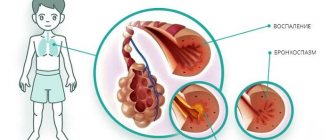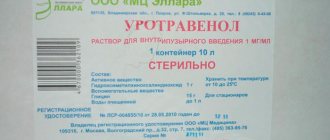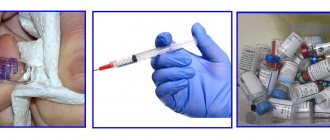Pharmacodynamics of the drug
The medication enters the bloodstream and after 15 minutes binds to proteins. Nimotop relieves an attack of hypertension. The therapeutic effect is observed within 16–24 hours. The medicine is excreted through the intestines and kidneys.
The increase in perfusion is most pronounced in affected areas of the brain where there is insufficient blood supply. With the help of Nimotop, it is possible to reduce the incidence of ischemic brain damage and reduce the mortality rate of patients.
The active substance directly acts on blood vessel receptors associated with calcium channels. Nimodipine normalizes the function of nerve cells without causing steal syndrome. The drug also improves the results of behavioral and personality reactions, psychometric tests.
Pharmacokinetics
Continuous infusion of 0.03 mg/kg/h nimodipine solution achieves steady-state plasma concentrations of 17.6 to 26.6 ng/mL.
Volume of distribution (Vdss) ranges from 0.9 to 1.6 L/kg body weight.
The degree of binding of nimodipine to plasma proteins is 97-99%.
Nimodipine is extensively metabolized mainly in the liver, which leads to the formation of products that lack pharmacological activity.
Metabolites are excreted approximately 50% through the kidneys and 30% through bile.
Indications for use
Nimotop is used as prescribed by a doctor. Tablets and solution have different indications.
When the drug is taken orally:
- Memory disorder, problems with remembering information.
- A disorder of the brain in older citizens, in which a person cannot concentrate on anything.
- Acute reaction to various external stimuli.
The solution is used in the following cases:
- Rupture of a cerebral aneurysm.
- Ischemic attack.
- Subarachnoid hemorrhage.
- Neurological disorders provoked by vascular spasm.
- The medication is used to prevent stroke and for intellectual disorders.
Contraindications
Nimotop has a number of contraindications, in the presence of which the product will have to be abandoned. The doctor will select another drug that is better suited to the patient.
Absolute contraindications:
- Age up to 18 years. The child's body does not accept the medicine well.
- Hypersensitivity to substances from the composition.
- Severe liver dysfunction - for example, cirrhosis.
- Pregnancy and lactation.
- Taking antiepileptic medications and rifampicin.
There are relative contraindications for which the doctor may prescribe medication. Treatment should be carried out with extreme caution. A medical professional will monitor any changes in your health. If your health condition worsens, it is recommended to discontinue the medication, as it is important to restore the full functioning of the organs.
Relative contraindications:
- Arterial hypotension – pressure less than 100 ml Hg.
- Unstable angina, the first month after acute myocardial infarction.
- Old age and severe renal dysfunction.
- Myocardial ischemia, bradycardia, heart failure, high blood pressure.
- Alcoholism, liver pathologies, epilepsy.
Patients are advised to undergo regular examinations to monitor changes in their health. If pathological signs are detected, Nimotop will need to be discontinued. Doctors insist on undergoing a full examination before prescribing medication. You need to make sure that there are no diseases for which the medication should not be used. The medical specialist will decide whether the drug can be prescribed for relative contraindications. If the body is weakened, you will have to undergo treatment with extreme caution.
Instructions:
Clinical and pharmacological group
01.019 (Calcium channel blocker with a predominant effect on cerebral vessels)
Release form, composition and packaging
The solution for infusion is slightly yellowish in color, transparent.
| 1 ml | 1 fl. | |
| nimodipine | 200 mcg | 10 mg |
Excipients: ethanol 96%, macrogol 400, sodium citrate, anhydrous citric acid, water for injection.
50 ml - dark glass bottles (1) complete with a connecting tube - cardboard boxes. 50 ml - dark glass bottles (1) complete with a connecting tube - cardboard packs (5) - polyethylene film.
pharmachologic effect
Calcium channel blocker. Nimodipine has a highly selective antispasmodic effect on cerebral vessels. Nimodipine prevents or eliminates vasoconstriction provoked by various vasoactive substances (for example, serotonin, prostaglandins).
In patients with acute cerebrovascular accidents, nimodipine dilates cerebral vessels and improves cerebral blood flow. The increase in perfusion tends to be greater in areas of the brain that have received insufficient blood supply than in uninjured tissue. Nimodipine significantly reduces the incidence of ischemic brain injury and mortality in patients with subarachnoid hemorrhage.
Nimodipine, acting on the receptors of the blood vessels of the brain associated with calcium channels, has a protective effect on nerve cells, stabilizes their function, improves blood supply to the brain, improves the tolerance of ischemia by nerve cells, without developing “steal syndrome”. Nimodipine has a beneficial effect on memory and concentration disorders in patients with impaired brain function. At the same time, personal and behavioral reactions and the results of psychometric functional tests improve.
Pharmacokinetics
Suction
With continuous infusion at a rate of 0.03 mg/kg/h, the average stable concentration of nifedipine in blood plasma is 17.6-26.6 ng/ml. After IV bolus infusion, a biphasic decrease in the concentration of nimodipine in the blood plasma is observed after 5-10 minutes and after approximately 60 minutes.
Distribution
Vd with intravenous administration is 0.9-1.6 l/kg body weight, total clearance is 0.6-1.9 l/h/kg.
Nimodipine intensively binds to blood plasma proteins (97-99%) and penetrates the placental barrier. Concentrations of nimodipine and its metabolites in breast milk significantly exceed concentrations in blood plasma. After intravenous administration, the concentration of nimodipine in the cerebrospinal fluid is about 0.5% of the concentration in the blood plasma.
Metabolism and excretion
Nimodipine is metabolized mainly by dehydrogenation of the dihydropyridine ring and oxidative cleavage of esters. The three main metabolites found in blood plasma do not have clinically significant activity.
The effect of nimodipine on liver enzyme activity has not been studied. Metabolites are excreted 50% by the kidneys and 30% by the bile.
Dosage
It is recommended to follow the following dosage regimen:
IV infusion
At the beginning of therapy, 1 mg of nimodipine per hour (5 ml of Nimotop® infusion solution), approximately 15 mcg/kg/h, is administered over 2 hours. If well tolerated (primarily in the absence of a noticeable decrease in blood pressure), after 2 hours the dose is increased to 2 mg of nimodipine per hour (approximately 30 mcg/kg/h). The initial dose for patients with body weight less than 70 kg or labile blood pressure should be 0.5 mg nimodipine per hour.
The infusion solution is used for continuous IV infusion through a central catheter using an infusion pump and a three-way stopcock simultaneously with one of the following solutions: 5% dextrose, 0.9% sodium chloride, Ringer's solution, Ringer's solution with magnesium, dextran solution 40 or 6% hydroxyethyl starch in a ratio of approximately 1:4 (Nimotop®/other solution). Mannitol, human albumin, or blood may also be used as a concomitant infusion.
Nimotop® solution must not be added to the infusion vessel or mixed with other drugs. It is recommended to continue the administration of nimodipine during anesthesia, surgery and angiography.
To connect the polyethylene tube (through which the Nimotop® solution is supplied), the channel for the supply of the accompanying solution and the central catheter, it is necessary to use a three-channel shut-off valve.
Prophylactic use. IV therapy with nimodipine should begin no later than 4 days after hemorrhage and continue throughout the period of maximum risk of developing vasospasm, that is, until 10-14 days after subarachnoid hemorrhage.
After completion of infusion therapy, over the next 7 days, oral administration of the tablet form of nimodipine at a dose of 60 mg 6 times a day with an interval of 4 hours is recommended.
Therapeutic use. If ischemic neurological disorders caused by vasospasm due to subarachnoid hemorrhage already occur, infusion therapy should be started as early as possible and carried out for at least 5 but not more than 14 days.
After completion of infusion therapy for the next 7 days, oral administration of the tablet form of nimodipine at a dose of 60 mg 6 times a day (every 4 hours) is recommended.
If, during the therapeutic or prophylactic use of Nimotop® solution, surgical treatment of hemorrhage is performed, IV nimodipine therapy must be continued for at least 5 days after surgery.
Introduction to the brain cisterns
During surgery, a freshly prepared nimodipine solution (1 ml of Nimotop infusion solution and 19 ml of Ringer's solution), heated to average body temperature, can be injected into the brain cisterns. The solution must be used immediately after preparation. If the patient experiences an adverse reaction to the drug, either reduce the dose or discontinue nimodipine therapy.
In severe liver dysfunction, especially with liver cirrhosis, the bioavailability of nimodipine may be increased due to a decrease in the intensity of primary metabolism and slower metabolic inactivation. The consequence of this may be an aggravation of the main and side effects of the drug, in particular, its hypotensive effect. In such cases, the dose of the drug should be reduced based on the degree of blood pressure reduction; if necessary, treatment should be interrupted.
Nimodipine is sensitive to light, so direct exposure to sunlight should be avoided: glass syringes and connecting tubes that are black, brown, yellow or red should be used; In addition, it is advisable to wrap the infusion pump and tubes in light-proof paper. In diffuse daylight or artificial lighting, Nimotop® can be used for 10 hours without special protective measures.
Nimodipine, the active substance of the Nimotop® infusion solution, is absorbed by polyvinyl chloride; for its parenteral administration, only systems with polyethylene tubing can be used.
Overdose
Symptoms: marked decrease in blood pressure, tachycardia or bradycardia, vomiting, pain in the epigastric region, symptoms of central nervous system dysfunction.
Treatment: in case of overdose, use of the drug should be stopped immediately. Symptomatic therapy is carried out. If there is a significant decrease in blood pressure, dopamine or norepinephrine should be administered intravenously. Specific antidotes for nimodipine are unknown.
Drug interactions
Nimodipine is metabolized by the CYP3A4 isoenzyme, so drugs that induce or inhibit the activity of liver enzymes may affect the plasma concentration of nimodipine.
Based on the experience with other slow calcium channel blockers, it can be expected that rifampicin, which is an inducer of liver enzyme activity, can accelerate the metabolism of nimodipine. With simultaneous use of rifampicip and nimodipine, the effectiveness of the latter may be reduced.
Antiepileptic drugs that induce the CYP3A4 isoenzyme (phenobarbital, fepitoin and carbamazepine) significantly reduce the bioavailability of nimodipine, so their combined use is contraindicated.
Drugs that induce the activity of the CYP3A4 isoenzyme may increase plasma concentrations of nimodipine: macrolides, for example, erythromycin (the structurally related azithromycin does not have such properties), HIV protease inhibitors (for example, ritonavir), azole antifungals (for example, ketoconazole), antidepressants nefazodone and fluoxetine, quinopristin/dalfopristin, cimetidine, valproic acid. When these drugs are prescribed together, the dose of nimodipine should be reduced and blood pressure monitored.
Long-term use of nimodipine with nortriptyline leads to a slight decrease in the concentration of nimodipine in the blood plasma; the concentration of nortriptyline remains unchanged.
Long-term use of nimodipine with fluoxetine leads to an increase in the concentration of nimodipine in the blood plasma by an average of 50%. The concentration of fluoxetine decreases significantly, while the content of the active metabolite of fluoxetine, norfluoxetine, does not change.
Nimodipine can lower blood pressure when co-administered with diuretics, beta-blockers, ACE inhibitors, AT1 receptor blockers, other calcium antagonists, alpha-blockers, methyldopa, phosphodiesterase inhibitors. When nimodipine is used together with drugs from these groups, careful monitoring of blood pressure is required.
In patients on long-term therapy with haloperidol, no drug interactions between nimodipine and haloperidol were detected.
In a study in monkeys, coadministration of zidovudine and an IV bolus of nimodipine resulted in a decrease in zidovudine clearance.
Calcium supplements reduce the effectiveness of nimodipine.
Concomitant therapy with potentially nephrotoxic drugs (eg, aminoglycosides, cephalosporins, furosemide) may cause renal dysfunction. In the case of such treatment, as well as in patients with renal failure, treatment should be carried out under close supervision. If renal dysfunction is detected, nimodipine should be discontinued.
Nimotop® infusion solution contains 23.7 vol.% ethanol; it is necessary to take into account the possible interaction of ethanol with other drugs.
Grapefruit juice inhibits dihydropyridine oxidation metabolism. The combination of grapefruit juice and nimodipine should be avoided because this may lead to increased plasma concentrations of nimodipine.
Use during pregnancy and lactation
The use of Nimotop during pregnancy always requires a careful assessment of the balance between benefit and risk factors, taking into account the severity of the clinical picture.
Side effects
From the cardiovascular system: significant decrease in blood pressure, especially with elevated initial values, flushing, bradycardia, tachycardia, feeling of heat in the head, increased sweating, development or worsening of existing heart failure and myocardial ischemia, peripheral edema.
From the digestive system: dyspeptic symptoms, nausea, diarrhea, constipation, flatulence, dry mouth, changes in appetite, increased activity of liver transaminases, alkaline phosphatase and GGT; rarely - ileus.
From the nervous system: dizziness, headache, weakness, tremor, fainting, hyperkinesis.
From the hematopoietic system: thrombocytopenia.
From the urinary system: impaired renal function with increased concentrations of urea and/or creatinine in the blood plasma.
Allergic reactions: rarely - skin rash, itching.
Local reactions: phlebitis (with the introduction of Nimotop® infusion solution into peripheral veins without an accompanying solution).
Storage conditions and periods
The drug should be stored in a dry place, protected from light and out of reach of children, at a temperature not exceeding 30°C. Shelf life: 4 years.
Indications
- prevention and treatment of ischemic neurological disorders caused by spasm of cerebral vessels against the background of subarachnoid hemorrhage due to rupture of an aneurysm.
Contraindications
— age up to 18 years;
- hypersensitivity to any of the components of the drug.
The drug should be prescribed with caution in case of arterial hypotension (systolic blood pressure less than 100 mmHg), severe bradycardia, myocardial ischemia, severe heart failure, increased intracranial pressure, generalized cerebral edema, liver and kidney failure.
The solution for intravenous infusion contains 23.7 vol.% ethanol, which should be taken into account when prescribing the drug to patients with chronic alcoholism with deterioration of ethanol metabolism, patients with liver diseases, epilepsy, during pregnancy, and during breastfeeding.
special instructions
The prescription of nimodipine to elderly patients with concomitant diseases, severe renal failure (glomerular filtration rate less than 20 ml/min) and severe cardiovascular diseases should be carefully justified. During therapy and after its completion, such patients require regular medical supervision.
In patients with impaired liver function, due to a decrease in the intensity of primary metabolism and slower metabolic inactivation, the bioavailability of nimodipine may increase. As a result, the main and side effects, in particular its hypotensive effect, may increase. In such cases, the dose of the drug should be reduced depending on the degree of reduction in blood pressure, and if necessary, nimodipine should be discontinued.
When treating, it should be taken into account that the solution for intravenous infusion contains 23.7 vol.% ethanol (200 mg of ethanol per 1 ml of solution) and 17% polyethylene glycol 400.
Impact on the ability to drive vehicles and operate machinery
Due to the possible development of dizziness and a decrease in blood pressure, the use of nimodipine may impair the ability to drive vehicles and machines. When using Nimotop® infusion solution, this factor usually does not matter.
Use for renal impairment
The prescription of nimodipine to patients with severe renal failure (glomerular filtration rate less than 20 ml/min) and severe cardiovascular diseases should be carefully justified. During therapy and after its completion, such patients require regular medical supervision.
Use for liver dysfunction
Contraindicated: severe liver dysfunction (for example, liver cirrhosis).
Conditions for dispensing from pharmacies
The drug is available with a prescription.
Side effects
Nimotop can cause various side effects. They mainly appear if the body is weakened, the dosage is not followed, or there are chronic diseases. After use, you will need to monitor changes in your well-being. Often the first side effects appear a few hours after the start of the course. Sometimes symptoms appear after 2-3 days. Any changes must be recorded and then consult a doctor.
Negative actions:
- From the nervous system: sometimes there is a headache.
- From the digestive system: from time to time, attacks of nausea occur; less often, patients experience intestinal obstruction.
- From the immune system: skin rash, allergic reaction.
- From the hematopoietic system: thrombocytopenia.
- From the cardiovascular system: sometimes blood pressure decreases, tachycardia and vasodilation occur, and bradycardia occurs less frequently.
- From the hepatobiliary system: the concentration of liver enzymes rarely increases.
Additional side effects may occur when using coated tablets. Patients report tremor, dizziness, hyperkinesia, and vertigo. Swelling, fainting, and increased heart rate may develop. Rarely, patients suffer from diarrhea, flatulence, and constipation.
Most of the side effects are observed in elderly patients with brain disorders. In case of obvious negative actions, it is recommended to consult a doctor. He will make a decision regarding the further use of Nimotop.
Compatibility with other drugs
When Nimotop is used simultaneously with certain medications, a number of effects are observed. If the patient is forced to take additional medications, you will have to make sure they are compatible with Nimotop.
Drug interactions:
- Medicines that inhibit the activity of liver enzymes lead to changes in the concentration of nimodipine in plasma.
- Rifampicin accelerates metabolism and reduces the therapeutic effect of Nimotop.
- Antiepileptic drugs that induce CYP3A4 reduce the bioavailability of nimodipine. Combination of drugs is strictly prohibited.
- Zidovudine increases the concentration of the active substance in plasma and reduces the volume of distribution.
- Calcium supplements worsen the therapeutic effect of nimodipine.
- Nephrotoxic drugs disrupt kidney function. With the progression of functional disorders of the organ, treatment is canceled.
- Grapefruit juice increases the concentration of nimodipine in the blood.
- Diuretics and beta-blockers reduce blood pressure, so monitoring blood pressure levels is required.
- Fluoxetine increases the concentration of nimodipine in the blood plasma.
Your healthcare professional will decide whether certain medications can be combined. It is recommended to read the instructions for use before using any drug. It indicates the compatibility of the medicine with other drugs. If the combination is incorrect, your health will worsen and the desired therapeutic effect will not occur. Any medications must be prescribed exclusively by a doctor.
Nimotop
Active substance:
Nimodipine*
Pharmgroup:
Calcium channel blockers
Analogs for the active substance:Brainal Dilceren Nimopin | Application area:External signs of aging Age-related eye disease Age-related visual impairment Age-related vascular diseases Age-related constipation Age-related changes in visual acuity Age-related involutional changes in the brain Age disorders Age-related hearing loss Secondary disorders of mnestic functions Gerontological practice Senile dementia Calcium and vitamin D3 deficiency in the elderly Diseases of the brain of a vascular and age-related nature Forgetfulness Difficulty concentrating Difficulty in mental functioning Mood changes Mood variability Involutional depression Involutional depressions Intellectual disability Intellectual-mnestic disorder Intellectual-mnestic disorder Mental infantilism Cognitive impairment Correction of metabolism in old and senile age Mood lability Memory impairment Intellectual impairment Violation of mnestic functions Violation of mental activity Thinking disorder Mood disorder Memory impairment Impaired mental performance Impaired thinking function Thinking disorders Mood disorders Memory disorders Malnutrition in old and old age. Instability of the emotional background Weakening intellectual productivity Memory loss Acute cerebrovascular insufficiency Mental retardation Memory decline Primary disorders of mnestic functions Mood swings Decreased intellectual-mnestic functions Decreased intellectual productivity Mental lability Absent-mindedness Thought disorders Mood disorders Behavioral disorders in old age Thought disorder Senile dementia Senile dementia Senile depression Senile colpitis Senile psychosis Age-related involutional syndrome Mixed emotional disorders Decreased intellectual-mnestic functions Decreased intellectual productivity Decreased intellectual capabilities Decreased intellectual abilities Decreased intellectual abilities in elderly patients Decreased mental function Decreased thinking function Decreased mood Memory loss in old age Decreased mental activity Age-related hearing loss Reduced intellectual level State of emotional tension Spasm of the arteries of the brain Cerebral vasospasm Spasm of cerebral vessels Spasms of cerebral vessels Aging Brain aging Aging of the body Senile dementia Senile age Senile involutional psychosis Senile psychosis Deterioration of intellectual-mnestic functions Worsening mood Memory impairment Decreased memory for recent events Memory impairment in elderly patients Memory impairment in elderly patients Chronic mental impairment Cerebral spastic syndrome Emotional lability Emotional tension Emotional instability Emotional instability Emotional withdrawal Emotional detachment |
Use of the drug
The tablets are taken orally, regardless of food. They are swallowed whole, washed down with pure water. Breaks between doses are at least 4 hours.
The recommended dose is 2 tablets. They are taken 6 times a day if an aneurysm ruptures. The course lasts up to 7 days.
For functional disorders of the brain, patients should take 1 tablet three times a day. The dosage is suitable for pensioners.
At the beginning of treatment, the infusion solution is administered over 2 hours at 1 mg per hour. If the drug is well accepted by the body, the dose is doubled. If the patient has a body weight of up to 70 kg, the initial dosage should be 0.5 mg per hour.
For neurological disorders of an ischemic nature, therapy is carried out for 1–2 weeks. After this, the medication will need to be taken orally.
The doctor will prescribe an individual treatment regimen for the patient depending on his or her health condition. Instructions for use are presented so that a person roughly understands how to be treated with Nimotop.
Release form and composition
The following dosage forms of Nimotop are produced:
- Film-coated tablets: biconvex, round, yellow, engraved in the form of a Bayer cross on one side and “SK” on the other side (in blisters of 10 pcs.; 3 or 10 blisters in a cardboard box);
- Solution for infusion: transparent, slightly yellowish (in dark glass bottles of 50 ml complete with a connecting tube; 1 or 5 sets in a cardboard pack).
1 tablet contains:
- Active ingredient: nimodipine – 30 mg;
- Auxiliary components: magnesium stearate, crospovidone, povidone, microcrystalline cellulose, corn starch;
- Shell: titanium dioxide, iron oxide yellow, macrogol, hypromellose.
1 ml of solution contains:
- Active ingredient: nimodipine – 0.2 mg;
- Auxiliary components: water for injection, anhydrous citric acid, sodium citrate, macrogol 400, ethanol 96%.
Overdose
In case of an overdose of tablets or infusion solution, blood pressure decreases, bradycardia and tachycardia occur. If the medication is taken orally, abdominal pain, vomiting, and central nervous system disorders will occur.
After an overdose, the medicine is discontinued. If the patient has taken pills, you will have to rinse the stomach and use activated charcoal. Next, the doctor will prescribe symptomatic treatment to normalize your well-being. If blood pressure drops significantly, norepinephrine will need to be administered intravenously.
special instructions
The drug is not always well accepted by the body. Elderly people with a large number of diseases are at risk. After identifying side effects, the doctor may reduce the dose. In severe situations, you have to stop using the medication.
The medication is not prescribed in childhood. If the patient is under 18 years of age, the doctor will select a more suitable drug. Nimotop has many side effects and contraindications, so you need to be careful when using it.
Reviews and recommendations from doctors and patients
Doctors and patients confirm that Nimotop is highly effective. It is used according to the instructions, since overdose causes obvious side effects. If your blood pressure drops, you will need to see a doctor immediately. It is important to stabilize the indicator so that your health does not worsen.
The use of a solution for infusion during pregnancy is allowed in extremely rare cases. The expected benefits must exceed the possible risks. Doctors note that the tablets are contraindicated for pregnant and lactating women.
Elderly patients say that the medication really supports brain activity. The first results appear a few days after the start of use. To achieve significant changes, you will need to undergo full treatment.
Nimotop is distinguished by its quality and not too high cost. It prevents strokes and is prescribed for medicinal purposes. After the first use, you must carefully monitor changes in your health. Doctors must make sure that the medication is well accepted by the patient's body. Otherwise, you will have to reduce the dosage or choose another drug. Mild side effects are allowed, but if the negative consequences are pronounced, you have to abandon the medicine and carry out symptomatic therapy.






